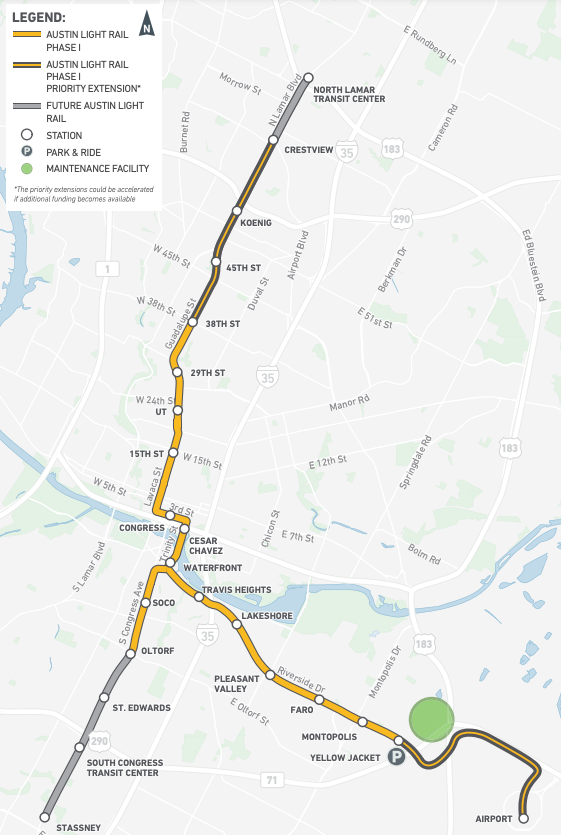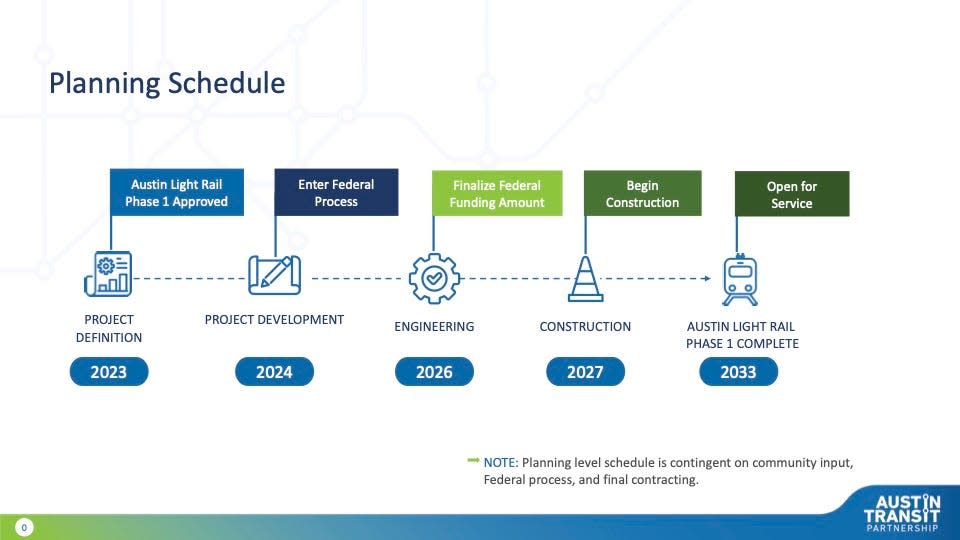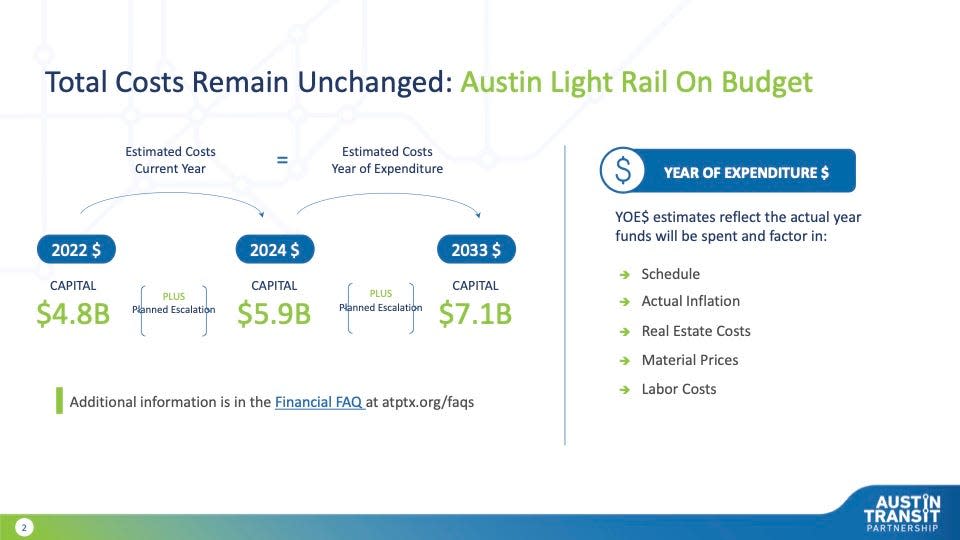Project Connect: Here's the latest timeline, cost estimates for Austin's light-rail plans
Austin's light-rail planners and their guiding board will meet Wednesday to discuss the latest on the transit project's planning and construction schedule.
Last week, nearly a year since scaling back its initial plans due to ballooning cost estimates, the Austin Transit Partnership gave local media a preview of what's to come during the meeting, including possible construction and completion dates.
Board members will consider taking action to further the ongoing process to earn funds from the Federal Transit Administration, from which the light-rail planning agency is seeking matching grant funds to cover at least 50% of the costs of construction of the system.
Here's a primer before the meeting, including an explainer on recently released cost estimates, where the line will and will not go, when to expect construction, and the looming court trial where the city's funding mechanism for the system is at issue.
What is the Austin Transit Partnership and how is it involved with Project Connect?
Building a light-rail system was a key selling point of Project Connect, the multibillion-dollar public transportation investment voters approved by a margin of 15 percentage points in 2020.
In the years since, the Austin Transit Partnership, the local government corporation created through an agreement between the city of Austin and Capital Metro, has worked to realize the plans, which have undergone a number of changes since voters approved the measure.
Approved last summer, the current plan calls for a 9.8-mile line running north, south and east of downtown Austin. The line could have between 13 and 16 stations, an operations and maintenance facility in East Austin and a number of smaller maintenance and storage facilities, planners have said.

With voter approval, the city raised the ad valorem property tax rate by 8.75 cents — an increase of more than 20% — to fund the investment. For the light-rail system, the most costly element of Project Connect, planners are betting on this tax and at least a 50% match in federal grant funding.
The pending legal action regarding Project Connect concerns whether the tax can be used to issue bonds to build the system. More on that below.
When will Austin's light-rail system be built?
Austin's light-rail planners expect construction to begin in 2027 and last about five years, finishing in 2033, according to a planning timeline provided to local media outlets.
The timeline also set expectations for when the Austin Transit Partnership expects the allocation of federal funds to the project will be finalized: 2026.

In February, the Austin Transit Partnership held a series of open house events as part of a federal environmental review process. That process could take more than 1½ years, and the results will factor into whether the agency receives federal funds.
How much is Austin's light-rail system going to cost?
It depends on how you look at the price tag.
In public meetings and documents published since the 9.8-mile plans were approved last summer, the Austin Transit Partnership has listed the cost between $4.5 billion and $4.8 billion — estimates made in 2022 dollars.
On Friday, speaking with local media, the planning agency presented a cost estimate of $7.1 billion that officials say accounts for a projected rise in construction costs and inflation by the time the system is completed in 2033.

In an interview, Greg Canally, the Austin Transit Partnership's executive director, said this kind of estimate in future dollars is typical for prolonged infrastructure projects of a scale similar to building a light-rail system. This estimate, he said, does not represent the project going over budget.
A cost breakdown coupled with the figure shows the largest chunk of funds, about $3.19 billion, would go toward the construction and engineering of the light-rail system. The rest goes toward three other buckets; professional services, $1.86 billion; the East Austin maintenance facility and vehicles, $1.11 billion; and real estate, $937 million.
How long has ATP known the $7.1 billion figure?
In a frequently-asked-questions document published last summer about the project's finances, the costs were shown in current year dollars. As the project moves forward, the "actual expenditures will be reflective of updated costs adjusted for inflation," the document reads.
The Austin Transit Partnership has known the inflation-adjusted cost estimate for the system since at least September, according to paperwork the light-rail planning agency submitted last fall to the Federal Transit Administration to qualify for federal grants and published on its website Friday.
Despite its internal estimate of the $7.1 billion adjusted cost in September, the Austin Transit Partnership continued sharing the estimate in 2022 dollars — omitting the estimates of the future value. The Friday preview to local media marked the first time the light-rail planning agency has publicized its cost estimate adjusted for inflation and future market value.
Why is ATP publicizing the adjusted cost estimate now?
Last week, the Federal Transit Administration notified the Austin Transit Partnership that the federal agency was moving into the final steps of the eligibility approval process. Canally said this step prompted the forthcoming Wednesday presentation to the guiding board of the light-rail planning agency.
From last fall until last week, the Austin Transit Partnership's eligibility submission to receive federal funds — which included the adjusted $7.1 billion estimate — had been in "draft form" as the two agencies worked to refine it, said Jennifer Pyne, the light-rail agency's executive vice president, in a statement Tuesday when asked about the gap.
Disclosures through other channels may have informed the decision. Before Austin Transit Partnership's preview to local media outlets, the $7.1 billion figure was first reported by Austin-based NPR affiliate KUT on Tuesday of last week.
The KUT report drew on records the outlet obtained through a federal records request — the same records Austin Transit Partnership declined to provide to the Statesman in response to a records request under the Texas Public Information Act.
In denying the Statesman's open records request, the Austin Transit Partnership cited a nonbinding opinion it received from the Texas attorney general's office saying the agency could withhold the records due to the pending litigation from burger restaurant Dirty Martin's Place.
Though the light-rail agency has changed its plans not to require the property Dirty's Martin's is on, the owner is proceeding with the lawsuit. Still, the transit agency published those records on its website Friday.
The decision to publish the materials online coincided with a deadline for attorneys representing Austin Transit Partnership to produce documents for plaintiff attorneys in the pending bond validation lawsuit.

What is the status of the Project Connect lawsuit?
There has been some movement here.
Last fall, critics of Project Connect filed a lawsuit centered on a number of its elements, including the city's proposed finance plan. That lawsuit was consolidated with a bond validation lawsuit attorneys representing Austin Transit Partnership filed in February.
Generally, the Texas attorney general signs off on bonds. However, Canally said, the Austin Transit Partnership filed the bond validation lawsuit to expedite the issuance of bonds and have a judge rule on the matter rather than Texas Attorney General Ken Paxton.
Earlier this month, the Republican attorney general filed a motion in the case, saying the city's proposed finance plan is unconstitutional. His motion echoed an opinion his office rendered during the last state legislative session when some lawmakers supported bills that would have undercut Project Connect. (Those bills fell short and did not become law).
A judge set a trial date for the pending bond validation lawsuit for May 28 through May 30.
Will light-rail run to Austin's airport?
No, for now.
As planned, the 9.8-mile line will fall short of the city-owned Austin-Bergstrom International Airport. It likewise will not run to Crestview Station, where it would connect to Capital Metro's six-day-a-week Red Line commuter rail service.
While the planning agency continues to express interest in the Crestview and airport connections, referred to as "priority extensions" by officials, they have not yet secured funding to bring them to fruition.
The environmental impact of the "priority extensions" is not being studied as part of the ongoing federal review process. Such a study, which itself can span more than a year or more, would be required should light-rail planners want to move forward with the extensions.
This article originally appeared on Austin American-Statesman: Here's the latest on Austin light-rail timeline, cost estimates
